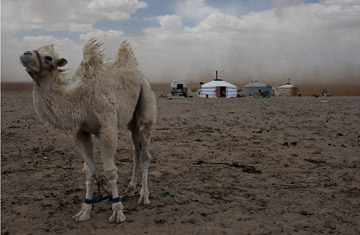
Nomads still live in traditional gers around Mongolia's biggest economic undertaking: the Oyu Tolgoi mine.
The Gobi is one of nature's most inhospitable creations. Traveling this vast expanse of gravel and sand in southern Mongolia, my eyes crave anything to ease the monotony of the parched panorama--a thorny scrub or pile of bleached camel bones. In summer the temperatures soar to 122F (50C); in winter they plummet below -40F (-40C). Somehow humans inhabit this desolate region: nomads with wind-chapped faces who hunker down in circular felt tents and raise herds of bony livestock. It is here, deep in the Gobi, that locals noticed earth of an incandescent blue. They named the area Oyu Tolgoi: Turquoise Hill.
Today in the wasteland that gave Marco Polo nightmares for years after he traversed it, a colossal encampment rises like a mirage. A little more than a decade after it was identified by foreign surveyors, Oyu Tolgoi is poised to become one of the world's five biggest mines, with some $350 billion worth of copper and gold reserves. Massive blue warehouses dot the landscape, while conveyor belts transport rocks from deposits roughly the size of Manhattan. Giant vehicles rumble by, their wheels more than twice my height. An international-standard airport is being built. The mine, which is controlled by Anglo-Australian outfit Rio Tinto and will begin early production later this year, teems with 18,000 workers from some 20 nations. In a place that is in the middle of nowhere, a strange order prevails. The cafeteria serves beef Stroganoff to foreign workers and lamb-offal soup to Mongolians. At the provisions shop, I can buy gummi bears, Snapple and fabric softener. The wi-fi in my ger, or traditional Mongolian tent, is faster than in my office in Beijing. Stepping into a bathroom stall, I am greeted by a sign that, in an effort to ward off desert dehydration, asks, "What color is your urine?"
For centuries, Mongolia loomed in the world's imagination as a byword for landlocked isolation. It is a country the size of Western Europe with fewer than 3 million citizens scattered across its lonely steppes. Fifteen times as many livestock animals--camels, horses, sheep, cows, goats and yaks--as people roam the land. Mongolia enjoyed its last heyday during the 13th century when Genghis Khan thundered across the steppes to create the largest land empire the world has ever known. During most of the 20th century, Mongolia slumbered under socialist rule. Even today, one-third of its people live as nomads.
But now Mongolia matters. A natural-resource boom has transformed the country, making it the fastest-growing economy on the planet last year, according to some estimates. In 2001, Mongolia was a $1 billion economy. A decade later, its GDP had reached $10 billion. At the same time, the country is a vital--and lonely--democracy in a tough neighborhood. To the north sits Russia, which during Soviet times turned Mongolia into a satellite state. To the south, west and east looms China, which for centuries also claimed dominion over it. Farther to the west spread the great plains of Central Asia, a political morass of personality cults and post-Soviet decay. Since peacefully overthrowing communism in 1990, Mongolia has charmed the world as the little democracy that could. "Our dream is to turn this small, backward country into the model of a modern country," says Puntsag Tsagaan, a director of the Oyu Tolgoi board and a top Mongolian administration official. "We have already come a long way."
